THE PECULIARITIES OF COMBAT IN MOUNTAINOUS TERRAIN
Dennis Jahn2024-05-06T05:20:04+00:00Foreword
Introduction: Mountain warfare, also known as alpine warfare, is a specialized form of military operation which takes place in rugged, high-altitude terrain. Throughout history, mountainous regions have served as formidable battlegrounds, presenting unique challenges and requiring specialized tactics, equipment, and training.
Historical Significance: Mountain warfare has played a significant role in numerous historical conflicts. From ancient battles in the Himalayas to the Alps in Europe, mountainous regions have witnessed fierce clashes which have shaped the course of wars. Examples include Hannibal’s crossing of the Alps during the Second Punic War, Napoleon Bonaparte’s campaigns in the Alps, and the epic struggles of World War I in the Dolomites and Julian Alps. These battles have showcased the unique challenges and opportunities presented by mountainous terrain.
Challenges in Mountain Warfare: Mountain warfare presents military units with a variety of challenges. The main obstacles include difficult access, rugged terrain, extreme weather conditions, and high altitudes. Soldiers and equipment must contend with steep inclines, narrow paths, and precipitous drops. Communication limitations, supplying troops, and medical evacuation pose additional challenges.
Tactics and Techniques: To address the challenges of mountain warfare, specialized tactics and techniques have evolved throughout history. This includes the use of mountaineers and mountain troops who specialize in vertical mobility and combat in difficult terrain. Tunnel and cave warfare, guerrilla tactics, the utilization of pack animals such as donkeys and mules for transportation, and the use of climbing and abseiling equipment are among the proven practices in mountain warfare.
Lessons from the Past: The history of mountain warfare offers important lessons for modern armed forces. The significance of acclimatization to high altitudes, the necessity for a flexible approach, the ability to employ improvised tactics, and the importance of coordination between infantry, artillery, and air support are just some of the lessons learned from past conflicts. Furthermore, the need for intensive training and the development of specialized mountain warfare units emphasizes the importance of ongoing learning and adaptation.
Modern Mountain Warfare: Modern mountain warfare has benefited from technological advancements, including air support, helicopter transportation, GPS navigation, drones and improved communication systems. Specialized equipment such as climbing gear, avalanche equipment, and lightweight weapons have been developed to meet the specific demands of mountain warfare. Additionally, tactical planning, training, and adaptability play a crucial role in meeting the challenges of modern mountain warfare.
Future Mountain Warfare: In the future, mountain warfare preparation will remain important for land forces to be mentally, physically and technically capable of surviving, moving and fighting in a mountainous environment. However, a key change will be the use of modern technology with a new approach. In the mountains, smaller, well-trained units will be more effective if they are able to employ the full range of combat capabilities (i.e. combined arms, multi-domain and cross-domain), even at the lowest tactical level. Future warfighting will no longer be a land-based force, but a multi-domain operation employing joint and combined arms tactics. Future armed forces, as part of joint, inter-organisational and multinational teams, will have to contend with dramatic advances in science and technology (artificial intelligence, hypersonic, robotics, directed energy, long-range precision fires, electronic warfare, advanced cyberspace, and others), which are being driven and amplified by the increasing pace of human interaction and societal change. Advances in weapons technology, sensors, communications and information processing capabilities are dramatically increasing lethality.
Conclusion: Mountain warfare is a unique form of military operations that requires specialized skills, equipment, and tactics to overcome the challenges posed by rugged and high-altitude terrain. By studying historical mountain warfare campaigns, armed forces can gain valuable insights and lessons which can shape their approach to modern mountain warfare or mountain warfare in future. With advancements in technology and ongoing training, military forces are better equipped to conquer the heights and succeed in mountainous environments. But regardless of this, many exercises and missions abroad have shown that proper training, appropriate equipment and a high level of physical fitness are the prerequisites for succeeding in mountain warfare. Soldiers equipped and trained for mountain warfare also excel in other climates, particularly extreme cold. The following article discusses the specifics of mountain combat.
THE SIGNIFICANCE OF MOUNTAINOUS REGIONS
Mountain terrain gains geopolitical relevance due to its widespread abundance of natural resources, as well as its importance for the energy and drinking water supply of urban centres. Mountain areas, covering approximately 32 million square kilometres, characterize a significant portion of the Earth’s surface. In countries like Norway, mountain ranges account for more than 90% of the land area. Mountains therefore have considerable strategic and operational importance in military operations. Even on the eastern flank of NATO, the terrain often shows mountainous characteristics. For example, the Carpathian Mountains stretch across several NATO states in Eastern and South-Eastern Europe, forming a westward-open arc over 1300 kilometres long and up to 350 kilometres wide, with elevations of up to 2655 metres in the HIGH TATRAS in SLOVAKIA.
CRITICAL INFRASTRUCTURE IN MOUNTAINOUS REGIONS
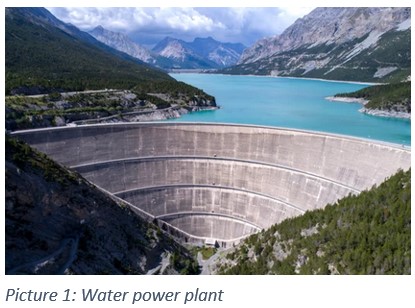 Mountainous areas typically have poor road networks and relatively low population densities but still hold significant geopolitical importance. The drinking water supply for a growing world population, primarily concentrated in large urban centres, is mainly ensured from mountainous regions. Additionally, for future energy supply – regardless of energy sources such as oil and gas – power plants and dams in mountainous regions play an increasingly important role and the often present mineral resources in mountainous regions are essential for our society’s resource dependent industries. Due to the fact that many regions of the Earth are traversed by mountains or exhibit mountain-like characteristics, the mountain aspect will inevitably play a significant role in future military operations.
Mountainous areas typically have poor road networks and relatively low population densities but still hold significant geopolitical importance. The drinking water supply for a growing world population, primarily concentrated in large urban centres, is mainly ensured from mountainous regions. Additionally, for future energy supply – regardless of energy sources such as oil and gas – power plants and dams in mountainous regions play an increasingly important role and the often present mineral resources in mountainous regions are essential for our society’s resource dependent industries. Due to the fact that many regions of the Earth are traversed by mountains or exhibit mountain-like characteristics, the mountain aspect will inevitably play a significant role in future military operations.
FUNDAMENTAL ASPECTS OF MOUNTAIN WARFARE
Mountain warfare can be fundamentally defined as the deployment of forces in terrain with significant differences in elevation, unique weather influences, and limited or entirely absent infrastructure. A static deployment of forces, such as the trench warfare practised by two armies from 1915-1918 in the mountain (e.g. Julian Alps), holds no promise of success in an era of combat helicopters and armed drones. Contemporary and future mountain warfare will continue to involve operations in vast and complex battlespaces with few axes of movement. However, it is now characterized by rapidly effective and far-reaching reconnaissance and engagement capabilities, as well as swift, mobile, and dispersed combat. These specific requirements, in turn, mean that only forces equipped, outfitted, and trained with specialized equipment and training can fulfil their military mission in mountain operations.
REQUIREMENTS FOR PERSONNEL
Mountain warfare places high demands on soldiers. These requirements, along with the specific influences of mountainous terrain, must be taken into account during personnel selection, particularly in course-based training and unit training. Terrain at risk of falling, long distances to the nearest infrastructure, and often rapidly changing and extreme weather conditions place the highest demands on the physical and mental resilience of deployed forces. Correspondingly capable, mountain-acclimated enemy forces – along with rapidly changing situations – further complicate matters.
Mobility, even under extreme conditions and in all seasons, is a crucial factor. The necessary skill profile is evident, starting with appropriate motor vehicles in the CATV (Cold Weather All-Terrain Vehicle) category, through unrestricted ski mobility in winter, to safely and quickly overcoming extreme rocky terrain.
In mountainous regions, within one’s own area of responsibility, both personnel and equipment readiness for rescuing and retrieving personnel must be ensured. This includes simple self-help measures (improvised mountain rescue), complex rescue operations including winch extraction by helicopter (planned mountain rescue), and the ability to conduct personnel recovery operations involving joint forces.
MOUNTAIN TRAINING (Example of the Mountain and Winter Warfare School / DEU / BUNDESWEHR)
The examples above highlight the necessity for comprehensive mountain training, both in summer and winter, for all forces deployed in mountain warfare. This training, coupled with mastery of infantry principles, is essential for successfully fulfilling missions in mountain operations.[1]
Suitable military leaders are trained at the Mountain and Winter Warfare School in Mittenwald to become Military Mountain Guides (MMGs) and Military High Mountain Specialists (MHMS) through a binational cooperation with the Austrian Armed Forces.
For the MMG qualification, one of the most prestigious within the BUNDESWEHR, soldierly demeanour, above-average mountaineering skills, sense of responsibility, willingness to perform, and enthusiasm for deployment are basic prerequisites. The unique features of the MMG qualification include: self-sufficient deployment in any difficult/extreme terrain, including extreme cold and high altitudes; leadership roles in rescue operations; and the ability to trigger controlled snow avalanches using explosive techniques. Upon successful completion of the extremely demanding almost year-long training, the MMG is capable of leading soldiers entrusted to them in any season, in any terrain, including rock, ice, and snow, in peacetime and in combat. Additionally, they actively advise their unit leaders and commanders on all aspects of service and combat in the mountains. The second-highest qualification, the MHMS, is achieved after both a six-week summer and winter course, enabling them to lead forces in mountainous terrain in all seasons and conduct combat tasks up to the subunit level.
Both of these qualifications are based on the comprehensive “Mountain Instructor” qualification, which is a significant milestone on the path to becoming a Mountain Ranger Sergeant and Mountain Ranger Officer. Thus, the mountain troops in the BUNDESWEHR are capable of performing movements in high mountains and independently overcoming short steep sections during ascent and descent (e.g. abseiling). In addition to this and many other training courses offered by the Mountain and Winter Warfare School, two courses stand out. Firstly, Mountain Rescue Training in both summer and winter, where participants acquire the ability to independently conduct partial aspects of mountain rescue operations under the supervision of an MMG, and to contribute to rescue missions; and secondly, High Mountain Sniper Deployment Training, conducted in both summer and winter, where participants are equipped with the skills to effectively employ their specialized sniper abilities in mountainous terrain and master accurate shooting under the specific influences of high-altitude environments.
[1] ATrainP-6 “Mountain Warfare / Training and Education
DANGERS AND CHALLENGES IN MOUNTAIN WARFARE
When forces are deployed after their mountain warfare training, the specific mission greatly depends on the terrain, prevailing season, and current weather conditions. During the planning phase, therefore, terrain and environmental factors must be given significant consideration to ensure adequate risk management independent of combat actions. A separate unit, the Mountain Cell, should be permanently implemented from at least battalion level upwards. Superficial knowledge of mountain warfare and ignorance or underestimation of mountain hazards and environmental effects result in mission failure and the unnecessary loss of life. It must therefore be stated that the respective commander needs “someone” who knows the specifics of the mountain and who can also assess the situation and thus provide the required advice or assessment contribution; this “someone” is the Mountain Cell which must be available 24/7 and up to date. The Mountain Cell is an element that is highly recommended in MW. It is part of the command post and/or HQ. It can work independently or it can be integrated into the chain of command, following national or task force regulations and/or orders. The tasks of the Mountain Cell include assessing the mountain situation, advising unit leaders, and creating and maintaining a mountain situation plan. In areas where no civilian avalanche situation report is available, the Mountain Cell also creates a military avalanche situation report. Additionally, the Mountain Cell has significant influence on assessing terrain and weather conditions for the unit’s own operations. Military mountain guides or mountain specialists support the Mountain Cell continuously by data collection with regard to the actual situation on the ground. This is done through traditional reconnaissance methods and standardized reporting formats. Ultimately, the key is timely and uninterrupted information dissemination at all command levels. Details are always regulated individually and situationally based on the specific mission in combat.
To even reach a favourable position for combat, steep rock faces, ravines, and narrow ridges often need to be secured in advance by specialists. The same terrain often requires a completely different approach in winter compared to summer, and in some seasons, certain terrain sections may be impassable and must be circumvented. Another significant factor that distinguishes mountain warfare from traditional infantry combat on flat terrain is the latent presence of objective and subjective mountain hazards, such as rock falls, avalanches, and icefalls. A thorough assessment of these hazards by well-trained and cautious military leaders, from planning to operational execution, is essential in order to reach the operational area without casualties and subsequently conduct combat with a chance of success. There are several historical examples illustrating that the majority of casualties in mountain warfare did not occur during actual combat engagements, but rather were due to the constant hazards inherent to mountain environments. To minimize these risks, in addition to careful assessment and ordered measures by the respective military leader, the physical fitness and experience of the soldiers are crucial to meet these high demands.
THE SIGNIFICANCE OF THE "SMALL COMBAT UNIT" IN MOUNTAIN WARFARE
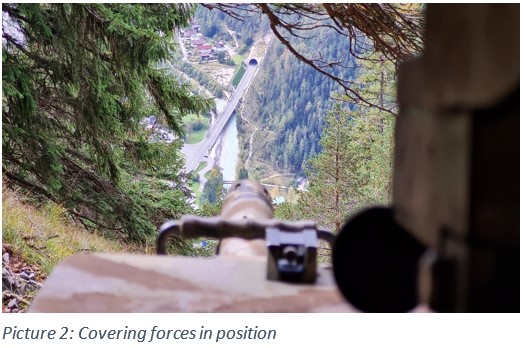 Combat in mountainous terrain is characterized by deployment across often stretched-out battle sectors, starting from the lowest echelons. While mountain warfare primarily revolves around fighting for the few favourable axes of movement, it is crucial in all tactical activities to control potential lines of movement from adjacent heights. This allows for slowing enemy forces down, monitoring one’s own progress, and securing vulnerable flanks. Depending on the situation, this often entails the autonomous deployment of forces in completely isolated operational areas. Utilizing reserves can be significantly delayed in mountain warfare, making the deployment of local reserves below the battalion level appropriate and practical when there is no feasible option for a rapid, all-weather airborne reserve deployment.
Combat in mountainous terrain is characterized by deployment across often stretched-out battle sectors, starting from the lowest echelons. While mountain warfare primarily revolves around fighting for the few favourable axes of movement, it is crucial in all tactical activities to control potential lines of movement from adjacent heights. This allows for slowing enemy forces down, monitoring one’s own progress, and securing vulnerable flanks. Depending on the situation, this often entails the autonomous deployment of forces in completely isolated operational areas. Utilizing reserves can be significantly delayed in mountain warfare, making the deployment of local reserves below the battalion level appropriate and practical when there is no feasible option for a rapid, all-weather airborne reserve deployment.
The small combat unit and mission command[2] gain special significance in mountain warfare due to this autonomy and isolation. To face this peculiarity of mountain warfare, the principle of mission command is a powerful and required leadership instrument. Mission command is, in general, the conduct of military operations based upon mission-type orders. The aim is that soldiers use, of their own volition, their whole intelligence and personality within their area of responsibility, on behalf of the commander´s intention to accomplish a distinct contribution to a mission or task. Terrain conditions often make it difficult to maintain reliable radio communication, so a clear internalization of the essential mission objectives becomes crucial in situations where deviation from the original plan may be necessary, potentially deciding the outcome of the engagement. It goes without saying that in mountain terrain, all movements and actions take a great deal of time, and a rapid change of focus or swift deployment of reserves is often not possible. Therefore, comprehensive and flexible planning and command are required to account for these factors as much as possible.
[2] ATP-3.2.1.3 CONDUCT OF LAND TACTICAL OPERATIONS IN MOUNTAINOUS ENVIRONMENT
AIR SUPERIORITY AS THE KEY TO SUCCESS
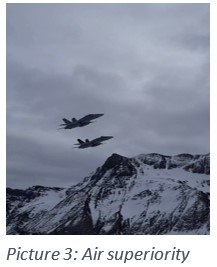 In current and future scenarios of mountain warfare, the available air assets play a decisive role in combat, alongside ground forces. The swift vertical deployment of forces such as mountain infantry or mountain reconnaissance units into favourable positions, as well as the utilization of combat helicopters and drones, are indispensable in mountain warfare today. With appropriate reconnaissance and engagement capabilities, enemy forces can be identified and engaged from a distance without exposing one’s own troops, and advantageous terrain can be seized by subsequently deploying friendly forces.
In current and future scenarios of mountain warfare, the available air assets play a decisive role in combat, alongside ground forces. The swift vertical deployment of forces such as mountain infantry or mountain reconnaissance units into favourable positions, as well as the utilization of combat helicopters and drones, are indispensable in mountain warfare today. With appropriate reconnaissance and engagement capabilities, enemy forces can be identified and engaged from a distance without exposing one’s own troops, and advantageous terrain can be seized by subsequently deploying friendly forces.
To establish and maintain air superiority, the deployment of radar-based reconnaissance and air defence assets at strategic points in the mountains is essential. In mountainous terrain, the maximum reconnaissance depth and range of these systems are only achievable at higher elevations without radar shadows. Mountain infantry is often required to secure these positions due to the adjacent difficult terrain. This aspect alone underscores a highly relevant example of the integration – and importance – of mountain troops in combined arms combat within the framework of national and Alliance defence.
SUPPLY IN THE MOUNTAINS
Logistics poses the greatest challenges in mountain warfare and the system of logistics determines the feasibility of operations in the mountains. A number of natural factors, such as differences in elevation, difficulties in terrain, lack of roads and infrastructure, snow, ice, and so on, hinder the usual (combat) service support systems and procedures. Differences in elevation, for example, represent a major logistical challenge, and in general the mountainous environment hinders logistics simply by restricting movement or slowing down its speed.
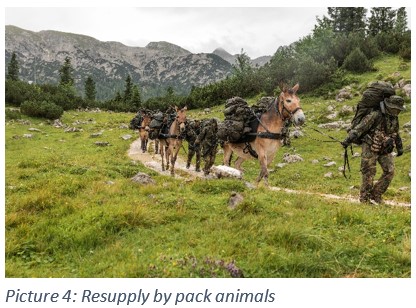 While the use of air-supported forces is essential for one’s own operational leadership, movements of ground forces in the mountains will often be necessary, especially in poor weather conditions. The significant altitude differences, even over short distances, greatly deplete the strength reserves of the troops. Therefore, in mountain warfare operations are conducted with valley and mountain logistics units. Supply in the mountains typically requires one-third of the available forces at all levels, with up to two-thirds of forces necessary under adverse conditions and without winter support to ensure supply!
While the use of air-supported forces is essential for one’s own operational leadership, movements of ground forces in the mountains will often be necessary, especially in poor weather conditions. The significant altitude differences, even over short distances, greatly deplete the strength reserves of the troops. Therefore, in mountain warfare operations are conducted with valley and mountain logistics units. Supply in the mountains typically requires one-third of the available forces at all levels, with up to two-thirds of forces necessary under adverse conditions and without winter support to ensure supply!
TACTICAL ACTIVITIES IN THE MOUNTAINS
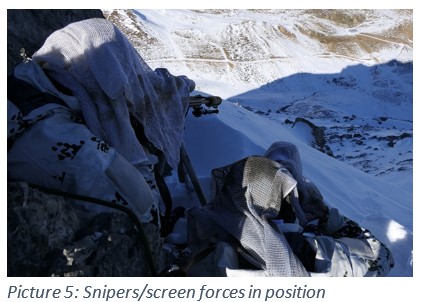 During the attack, the emphasis lies on “valley attack” in the valley floors, which can also be traversed by combat and infantry fighting vehicles. The mountain infantry is deployed along the accompanying heights during the mountain attack to protect the flank of the attacking forces, support the attack in the valley with direct and indirect fire from elevated positions, attack the enemy’s flanks or rear, and provide necessary elevation and security for combat support forces. An attack above the tree line in barren, vegetation-free, and particularly exposed terrain contradicts infantry principles, which state that infantry is generally deployed in terrain with ample cover and significant terrain features, such as wooded areas or urban spaces. However, this requires certain conditions in combat, such as air superiority; substantial fire concentration to effectively suppress the enemy, for example, the use of indirect fire; employment of the MELLS anti-tank system; heavy infantry weapons; or air-mechanized forces. Conversely, in the phase “approach”, exploiting limited visibility due to fog or precipitation is often advantageous. If this is not the case, substantial artificial fog must be present and utilized. The goal should always be to generate a very high element of surprise through terrain selection and time of day for the approach, assault starting position, and breach point.
During the attack, the emphasis lies on “valley attack” in the valley floors, which can also be traversed by combat and infantry fighting vehicles. The mountain infantry is deployed along the accompanying heights during the mountain attack to protect the flank of the attacking forces, support the attack in the valley with direct and indirect fire from elevated positions, attack the enemy’s flanks or rear, and provide necessary elevation and security for combat support forces. An attack above the tree line in barren, vegetation-free, and particularly exposed terrain contradicts infantry principles, which state that infantry is generally deployed in terrain with ample cover and significant terrain features, such as wooded areas or urban spaces. However, this requires certain conditions in combat, such as air superiority; substantial fire concentration to effectively suppress the enemy, for example, the use of indirect fire; employment of the MELLS anti-tank system; heavy infantry weapons; or air-mechanized forces. Conversely, in the phase “approach”, exploiting limited visibility due to fog or precipitation is often advantageous. If this is not the case, substantial artificial fog must be present and utilized. The goal should always be to generate a very high element of surprise through terrain selection and time of day for the approach, assault starting position, and breach point.
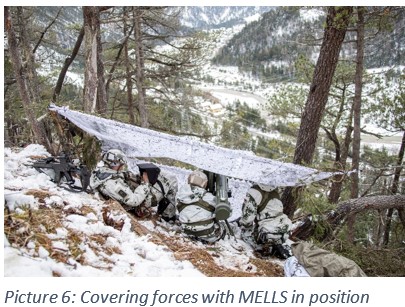 During the attack, once a breakthrough into enemy positions has been achieved, immediate reinforcement with additional assault groups and continued direct fire support from heavy weapons becomes crucial. On capturing the objective, particular attention must be given to resupplying ammunition, providing medical care to the wounded, and evacuating them. To exploit the success of the attack and to pursue the enemy in the mountains, specially trained mountain-mobile or ski-mobile forces should be allocated. Utilizing one’s own air transport capacity during this phase of the attack, to maintain momentum and conserve forces, should also be organized.
During the attack, once a breakthrough into enemy positions has been achieved, immediate reinforcement with additional assault groups and continued direct fire support from heavy weapons becomes crucial. On capturing the objective, particular attention must be given to resupplying ammunition, providing medical care to the wounded, and evacuating them. To exploit the success of the attack and to pursue the enemy in the mountains, specially trained mountain-mobile or ski-mobile forces should be allocated. Utilizing one’s own air transport capacity during this phase of the attack, to maintain momentum and conserve forces, should also be organized.
In mountain defence, the focus of combat operations is also in the valley, along the likely axis of advance of armoured enemy forces. Mountain infantry is again deployed along the challenging or extreme terrain of the valley’s accompanying high ground to deny the enemy the use of the heights; promptly detect enemy encirclements; support the defence of one’s own (armoured) troops in the valley with direct and indirect fire from elevated, forward positions; enable and secure the elevation advantage for combat support forces; and conduct counterattacks downhill from above. Due to logistical challenges in defence, few but optimally suited weapons and, notably, above-average amounts of ammunition are typically carried.
While delaying actions in the mountains may seem contrary to infantry principles at first glance, it can be feasible in certain situations, as mountains often provide favourable opportunities to slow down and exhaust enemy forces. The terrain often acts as a natural barrier, significantly impending attacking forces. The use of obstacles is usually highly effective, and combat distances can be exploited to their maximum range. Open terrain is often difficult for the enemy to traverse, resulting in substantial losses. However, the core challenge remains synchronizing one’s own movements during evasion. Mechanized forces are typically used in delaying actions in valley floors, as they can achieve much higher speeds than dismounted troops in mountain terrain. To address this challenge, once again, airborne deployment of forces is a viable option to ensure the high mobility demanded by delaying actions for dismounted forces deployed in mountainous terrain.
MOUNTAIN TROOPS AND THEIR SPECIAL ORGANIZATION
To account for all these unique factors, mountain infantry forms the core of the German Mountain Infantry Brigade 23 as the Army’s forces for combat in the most challenging terrain and extreme weather conditions. The mountain infantry battalions are specially structured, equipped, and trained for this purpose. Additionally, mountain infantry, alongside Special Forces, are the only troop type in the Army capable of ski mobility, ensuring high combat mobility even in winter weather conditions.
In addition to the three mountain infantry battalions, the Mountain Infantry Brigade also has a mountain reconnaissance company with a high mountain reconnaissance unit, a mountain engineer company with capabilities such as building cable cars, and two mountain supply companies. Additionally, the Mountain Infantry Brigade has a Mission and Training Centre for Pack Animals, which through pack animal support conserves troops’ energy and ensures supply in inaccessible terrain and under all weather conditions. To coordinate all these assets the development of a ground-based supply[3] plan is essential.
Within the three mountain infantry battalions, which form the nucleus of the brigade, special consideration is given to the requirements of mountain combat by incorporating an additional high mountain infantry platoon. This platoon supports the mountain infantry companies in extreme terrain and is generally employed as a cohesive unit. The high mountain infantry platoon is typically directly led by the mountain infantry battalion and is only assigned to a mountain infantry company in exceptional circumstances. Furthermore, the platoon is equipped for reconnaissance with extended reconnaissance depth and includes additional sniper squads. Thus, optimal conditions for combat against infantry forces in the mostly cover-free high mountains are created in remote areas between 1000m and 1800m. To ensure high mobility in high the mountains, two of the mountain infantry battalions are equipped with the BV 206 snow vehicle.
[3] ATP-3.2.1.3 CONDUCT OF LAND TACTICAL OPERATIONS IN MOUNTAINOUS ENVIRONMENT, Chapter 3.4 Sustainment
Conclusion
Mountain warfare places high demands on personnel and equipment. To successfully conduct it, it is crucial to achieve superior mobility and effectiveness in joint combat operations with a well-trained, experienced, and specially equipped force tailored to the mission, thereby decisively influencing the battle in one’s own favour.




